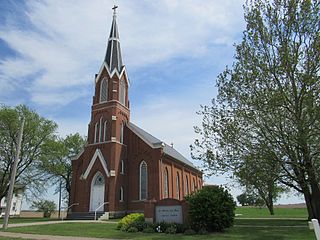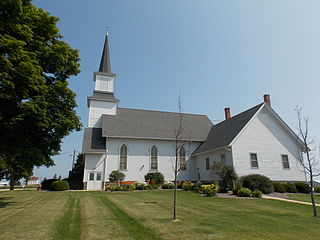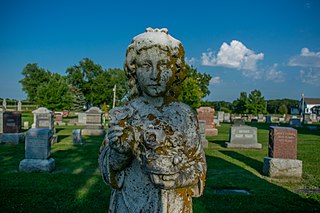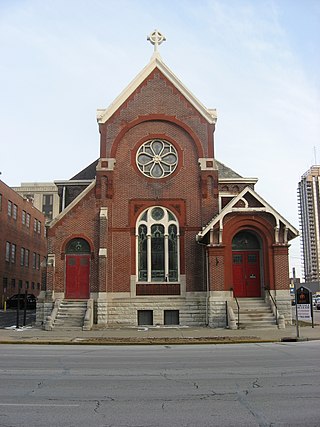
The Church of St. James the Less is a historic Episcopal church in Philadelphia, Pennsylvania, that was architecturally influential. As St. James-the-Less Episcopal Church, it was designated a National Historic Landmark for its Gothic Revival architecture, which influenced a generation of subsequent churches.

The Prayer Temple of Love Cathedral is located at 12375 Woodward Avenue in Highland Park, Michigan. It was built in 1929 as the Grace Evangelical Lutheran Church, and was listed on the National Register of Historic Places in 1982.

Saints Peter and Paul Roman Catholic Church is a former parish church of the Diocese of Davenport. The church is located southeast of Harper, Iowa, United States, in Clear Creek Township, Keokuk County. The church building was individually listed on the National Register of Historic Places in 1986. The parish property was listed as a historic district in 2021. The parish was known in the Davenport Diocese as Saints Peter and Paul, Clear Creek.

St. Paul Lutheran Church is located in central, Davenport, Iowa, United States. It is affiliated with the Evangelical Lutheran Church in America (ELCA). The church's original property, which subsequently housed other Protestant congregations, was listed on the National Register of Historic Places in 1983, but has since been torn down. The present complex was built in 1952 and contains two buildings that are contributing properties in the Vander Veer Park Historic District. The present church building was completed in 2007.

Old East Paint Creek Lutheran Church is located north of Waterville, Iowa, United States. The church building was listed on the National Register of Historic Places in 1983.

Walnut Street Baptist Church is a church building in downtown Waterloo, Iowa, United States. It has also been known as Faith Temple Baptist Church.

Augustana Lutheran Church is an Evangelical Lutheran Church in America congregation located in Sioux City, Iowa, United States. The church building was listed on the National Register of Historic Places in 2006 as Swedish Evangelical Lutheran Augustana Church.

Our Savior's Kvindherred Lutheran Church is an Evangelical Lutheran Church in America congregation located near the town of Calamus in rural Clinton County, Iowa, United States. The church and former school buildings as well as the church cemetery were listed as an historic district on the National Register of Historic Places in 2000.

The Norway Lutheran Church and Cemetery was located 10 miles from south of Denbigh, North Dakota and were listed on the National Register of Historic Places (NRHP) in 1994. The NRHP listing includes the main church structure, a cemetery, and two contributing privies to the west and rear of the church, all situated on a 4.4 acres (1.8 ha) site. A pyramid-shaped monument topped with an iron cross is located at the northeast corner of the cemetery and marks site of an older log church. Norwegian skier Sondre Norheim was buried in the cemetery in 1897.

Scotch Ridge United Presbyterian Church is a historic structure located in rural Warren County, Iowa, United States. It was built in 1883 and listed on the National Register of Historic Places in 1976. The founders of the church were Scotch-Irish immigrants who could trace their ancestry to Scotland and were proud of their Scottish heritage.

Swedish Evangelical Lutheran Church, now known as Swedesburg Evangelical Lutheran Church, is a historic church located in Swedesburg, Iowa, United States. The congregation was officially organized in 1866 by the Swedish Lutheran congregation from New Sweden in Jefferson County, Iowa. The present church was built in 1928 as the third church to stand on the same site. The first frame church, built in 1868, was destroyed in a fire in 1883. The second frame church, with a 110-foot (34 m) tower, was completed the same year. In 1927 it too was also destroyed by fire. The congregation hired Burlington, Iowa architect W.F. Weibley to design the present Late Gothic Revival church building. It is composed of tan brick with Bedford stone trim. The church was added to the National Register of Historic Places in 1999.

Union Presbyterian Church is a historic building located northwest of Stacyville in rural Mitchell County, Iowa, United States. Early settlers to the area of German descent established the Presbyterian congregation in the late 1850s. They initially worshiped in the homes of various church members before joining St. Peter's Lutheran Church in nearby Toeterville. Doctrinal differences resulted and the Rev. Jacob Kolb reformed the Presbyterian congregation in 1873 or 1874. Services were held in a schoolhouse until this church building was erected in 1888. It is a small frame structure with Gothic-style elements, with extensive use of pressed tin on the interior. A cemetery is located on the church grounds. Services were held in German until 1918. There was a steady decline in membership until the congregation was disbanded in 1975. The building was listed on the National Register of Historic Places in 1977.

Hebron Church is a mid-19th-century Lutheran church in Intermont, Hampshire County, in the U.S. state of West Virginia. Hebron Church was founded in 1786 by German settlers in the Cacapon River Valley, making it the first Lutheran church west of the Shenandoah Valley. The congregation worshiped in a log church, which initially served both Lutheran and Reformed denominations. Its congregation was originally German-speaking; the church's documents and religious services were in German until 1821, when records and sermons transitioned to English.

Sharon Cemetery Historic District is located in rural Harrison Township, Lee County, Iowa, United States near the town of Farmington. It was listed on the National Register of Historic Places in 1991. At the time of its nomination the historic district included four contributing buildings, one contributing site, eight contributing structures, and one contributing object.

St. John's Lutheran Church is located in rural Franklin County, Iowa, United States, west of the city of Hampton. The church property was listed as a historic district on the National Register of Historic Places as St. John's Danish Evangelical Lutheran Church in 2015. At the time of its nomination it contained ten resources, which included five contributing buildings, two contributing sites, one contributing structure, one contributing object, and one non-contributing structure.

Mount Pisgah Lutheran Church, also known in its early years as the First Lutheran Church and First English Lutheran Church and more recently as The Sanctuary on Penn, is located at 701 North Pennsylvania Street in downtown Indianapolis, Indiana. The historic church was built by the city's first Lutheran congregation, which organized in 1837, and was its third house of worship. The former church, whose present-day name is The Sanctuary on Penn, is operated as a for-profit event venue.

The Kimballton West 2nd – West 3rd Street Residential District is a nationally recognized historic district located in Kimballton, Iowa, United States. It was listed on the National Register of Historic Places in 1995. At the time of its nomination the district consisted of 82 resources, including 26 contributing buildings, 11 contributing objects, and 27 non-contributing buildings. The district mostly contains houses and outbuildings associated with the dwellings. They are all frame construction with locally produced brick, clay tile block, or concrete block foundations. Most of the lots are large the house size is a matter of taste or preference. For the most part the houses are 1½-stories, but there are also single-story and two-story structures. Residential architectural styles in the district include Queen Anne, Colonial Revival, and American Craftsman. There are no high style examples in the district. The frame, Gothic Revival, Immanuel Lutheran Church (1904) is located on Second Street, and is individually listed on the National Register.

Grace Methodist Episcopal Church, also known as Mount Moriah Missionary Baptist Church, is a historic building located in Waterloo, Iowa, United States. The congregation that built this building was organized in 1861 as First Methodist Episcopal Church. They built church buildings in 1865 at Lafayette and East Fifth Streets, and then at East Fourth and Mulberry Streets in 1877. They changed their name to Grace in 1895. They completed this building at Walnut and East Fifth Streets in 1913. The brick, Neoclassical structure designed by Turnbill & Jones features a large central dome and a large classical portico with six Ionic columns. Mount Moriah Missionary Baptist Church acquired the building from Grace United Methodist in 1996. The building was listed on the National Register of Historic Places in 2011.

West Paint Creek Synod Evangelical Lutheran Church and Cemetery is a historic building and site located northwest of Waterville, Iowa, United States. The church building and its adjacent cemetery were listed together on the National Register of Historic Places in 2019.
St. Paul Lutheran Church and Cemetery is a historic Lutheran church and adjoining cemetery located in Brule Township, rural Union County, South Dakota. It is located near Richland and about 5 miles (8.0 km) northwest of Elk Point. First built in 1867, it was the first Norwegian Lutheran church in Dakota Territory. The cemetery dates to 1869 and the current church building was finished in 1922. The site was listed on the National Register of Historic Places on February 20, 2018, for its historic, religious, and architectural significance.






















